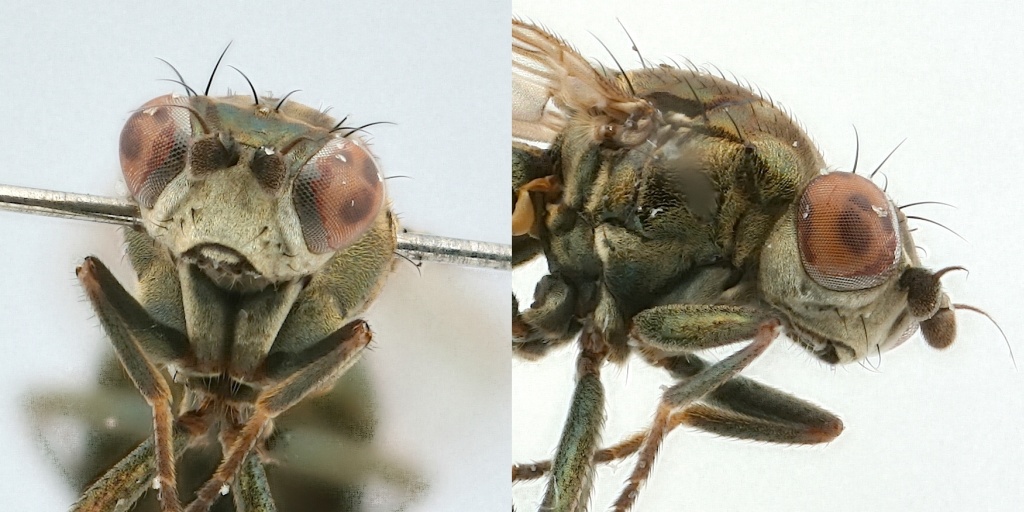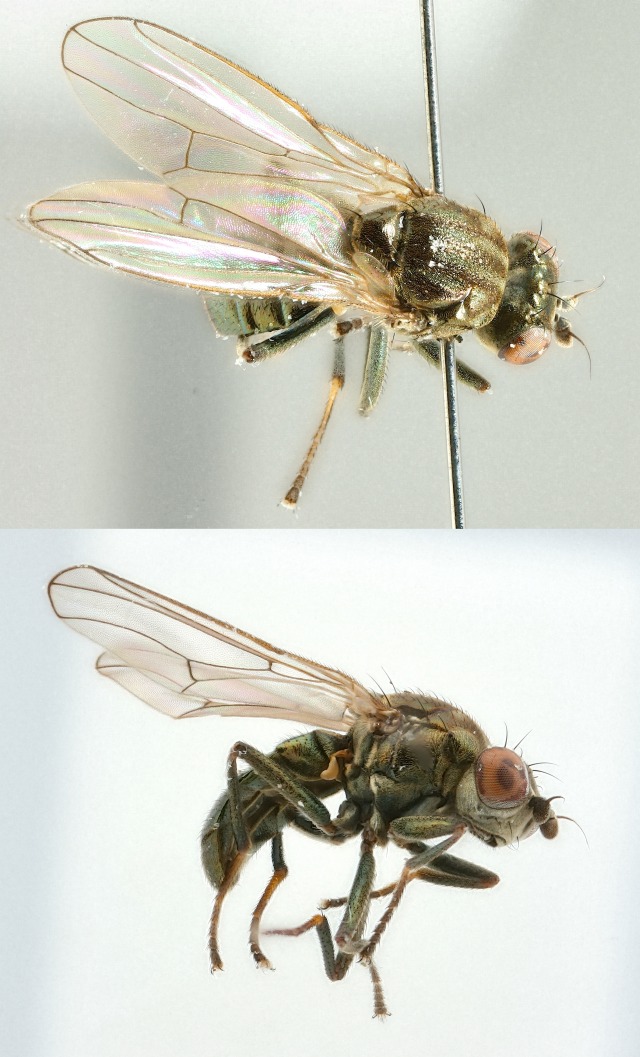Diptera.info :: Identification queries :: Diptera (adults)
|
Which Ephydridae? Two pictures.
|
|
| Walther Gritsch |
Posted on 12-02-2010 22:07
|
|
Member Location: Copenhagen Posts: 290 Joined: 31.01.09 |
This small Ephydridae (some 3 mm) has outsmarted me every time I've tried to key it. I guess it is somewhere around Parydra, but I'm not convinced. The fly was caught on 3. iv 2009 in a mixed forest on sandy soils near Copenhagen. It has, by the way, the honour of being the only Ephydridae in my collection - believe it or not! Walther Gritsch attached the following image:  [180.15Kb] Walther |
|
|
|
| Walther Gritsch |
Posted on 12-02-2010 22:08
|
|
Member Location: Copenhagen Posts: 290 Joined: 31.01.09 |
Second shot...
Walther Gritsch attached the following image:  [152.59Kb] Walther |
|
|
|
| Cranefly |
Posted on 13-02-2010 07:41
|
|
Member Location: Shachovskaya Posts: 647 Joined: 17.09.08 |
This may be genus Pelina.
Edited by Cranefly on 13-02-2010 08:16 |
|
|
|
| Walther Gritsch |
Posted on 13-02-2010 14:43
|
|
Member Location: Copenhagen Posts: 290 Joined: 31.01.09 |
Well, I did consider Pelina, but the two notopleurals are supposed to be equidistant from the notopleural suture. This suture must be the one between the notopleuron and the anepisternum. This fly has the posterior notopleural farther from the suture than the anterior. On the other hand the subcranial cavity isn't quite large enough for it to be Parydra sp. The question remains... Walther |
|
|
|
| Cranefly |
Posted on 13-02-2010 15:48
|
|
Member Location: Shachovskaya Posts: 647 Joined: 17.09.08 |
There are such genera close to Parydra. The main difference is: crossvein rm is disctinctly below junction of R1 and costa or 1/5 or less of distance from junction of R4+5 and R2+3 to costa - Callinapaea, Eutaenionotum and Rhinonapaea. Crossvein rm disctinctly beyond junction of R1 and costa or this distance 1/4 or more - Parydra. Check it please at the fly. Not easy to count but possible to compare with Parydra wing. (Clausen, Cook, 1971). I have never seen Callinapaea, but as for orbital setae large and subequal in length to either inner or exterior vertical setae - it may be Rhinonapaea - and the only species of this genus is Rhinonapaea metallica Cole. The species has artctic disctribution - northern coasts of America and Eurasia. But Rhinonapaea has no stripes on thorax according to description. I hope Tony Irwin will look at the photo too - possibly there is some other result for this fly. |
|
|
|
| Walther Gritsch |
Posted on 13-02-2010 19:37
|
|
Member Location: Copenhagen Posts: 290 Joined: 31.01.09 |
R-M is located only slightly beyond the junction of R1 and C - in reality what you see in the dorsolateral shot. I was careful to place the wing at right angles to the camera for this to be seen. If it were Rhinoapaea I reckon it would be a very unexpected find! I still have doubts whether the subcranial cavity of this fly is large and gaping enough to direct it towards e.g. Parydra and the likes. Yes, let's hope Tony Irwin has something to say about this (others are welcome too  ) )
Walther |
|
|
|
| Tony Irwin |
Posted on 13-02-2010 19:43
|
|
Member Location: Norwich, England Posts: 7318 Joined: 19.11.04 |
This is Pelina, and looks like P. aenea. The notopleural bristles are approximately the same distance from the notopleural suture (which forms the base of the notopleural triangle). In those genera where the rear bristle is farther away, it is four or five times the distance (see http://www.dipter...d_id=27883 )
Tony ---------- Tony Irwin |
|
|
|
| Walther Gritsch |
Posted on 13-02-2010 19:57
|
|
Member Location: Copenhagen Posts: 290 Joined: 31.01.09 |
Thanks Tony! It finally got a name. Pelina aenea seems to be spot on: Scutellum all smooth and shiny. Scutum dull and clearly punctured. Wings without spots. All of this according to Becker in Lindner. The help of both of you is much appreciated. Walther |
|
|
|
| Cranefly |
Posted on 13-02-2010 20:06
|
|
Member Location: Shachovskaya Posts: 647 Joined: 17.09.08 |
Pelina aenea according to the key: anepisternum pollen not shining, face even without depression below antennae, third antennal segment completely black, scutellum without apical papilla. If it is male - then genitalia large, reaching 2nd abdominal segment. Many thanks, Tony  |
|
|
|
| Jump to Forum: |












